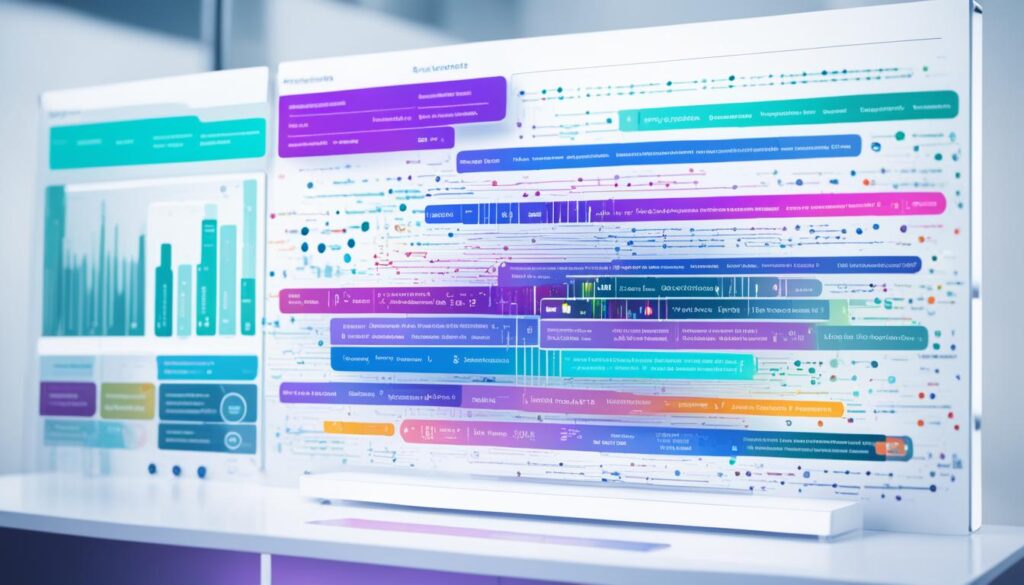Existing customer? Sign in
Best Machine Learning Software Tools 2024

As technology races forward, the frontier of machine learning software is expanding with a promise to reshape how we interact with data at every level. In 2024, you’re poised to witness an array of innovative machine learning tools defining the bleeding edge of data analysis solutions, predictive modeling tools, computer vision software, and natural language processing software. These intelligently designed tools are not just facilitators; they are revolutionary catalysts fuelling strides in efficiency and insights across various sectors, from healthcare to finance.
Machine learning’s ascendance is earmarked by its seamless integration of advanced AI algorithms and deep learning platforms which are set to become even more sophisticated by 2024. Your journey through the landscape of upcoming software tools will reveal how automated data processing is no longer a luxury but a fundamental component in cutting-edge technology solutions. Let’s delve into the future and understand which tools will lead the charge in transforming data into actionable, strategic assets.
Key Takeaways
- An evolution in machine learning software is set to revolutionize diverse industries in 2024.
- Innovative tools will greatly enhance data analysis solutions, streamlining the transformation of raw data into clear insights.
- Expect to see new frontiers in predictive modeling tools that forecast trends with unprecedented accuracy.
- Advances in computer vision software and natural language processing software will break down barriers in communication and interpretation.
- 2024 will showcase the seamless fusion of complex AI algorithms with user-centric interfaces, making advanced analytics accessible to a larger audience.
- The focus will sharp intensively on the integration of deep learning platforms into daily operations, enhancing both efficiency and decision-making.
Understanding Machine Learning Software Essentials
As we delve into the intricacies of machine learning software, it’s important to recognize its foundational position within the realm of artificial intelligence software. This software category is not just a technological trend, but a transformative tool for automated data processing and adaptive analytics. Here, we establish a clear definition and explore the distinguishing features that set apart superior machine learning platforms.
Defining Machine Learning Software
At its core, machine learning software embodies a segment of artificial intelligence that equips systems with the competency to autonomously learn and evolve from experience. This dynamic is achieved without explicit programming for each new context, allowing the software to uncover insights and refine its algorithms through continuous data interaction.
Key Features of Top Machine Learning Platforms
A discerning look at the market’s leading platforms reveals several non-negotiable features that these robust machine learning platforms must possess:
| Feature | Description | Benefit |
|---|---|---|
| Scalability | Ability to handle growing amounts of work or expand potential use cases. | Ensures longevity and adaptability of the platform as demands escalate. |
| Robust AI Algorithms | Advanced and diverse set of algorithms capable of tackling complex tasks. | Enhances the accuracy and efficiency of data analysis and decision-making processes. |
| User-friendly Interface | Intuitive design and ease of use for various skill levels. | Democratizes access and reduces the learning curve for users. |
| Comprehensive Data Analysis Solutions | A full suite of tools for analyzing and visualizing data. | Provides deep insights and facilitates informed decision-making. |
Recognizing these attributes in machine learning software is vital for harnessing the full potential of artificial intelligence within your projects, ensuring not only sophisticated automated data processing but also scalability and ease of use.
Selecting the Right AI Algorithms for Your Projects
In the complex realm of artificial intelligence, choosing the most suitable AI algorithms is a pivotal decision that can define the success of your project. Whether you’re working with neural networks, decision trees, or clustering methods, it is vital to match your choice to the specific needs of your project including the data type, scale, and desired outcome.
The process involves understanding the strengths and limitations of various machine learning software and how they align with your objectives. For instance, if your venture deals with vast amounts of unstructured data, deep learning algorithms might be ideal due to their proficiency in recognizing patterns.
Remember, an algorithm’s elegance or complexity should not dictate choice—suitability should.
- For regression and classification tasks, consider algorithms like Logistic Regression or Support Vector Machines.
- If your work involves networks or systems, algorithms such as Neural Networks or Bayesian Networks may be effective.
- For clustering large datasets, you might benefit from K-Means or Hierarchical Clustering.
- When dealing with sequential data, Recurrent Neural Networks or Long Short-Term Memory networks are valuable tools.
Let’s illustrate this with a comparative analysis:
| Project Type | Suitable AI Algorithm | Benefits |
|---|---|---|
| Data Prediction | Random Forest | Handles large datasets with multiple variables |
| Image Recognition | Convolutional Neural Network (CNN) | Exceptional for spatial data analysis |
| Time Series Analysis | AutoRegressive Integrated Moving Average (ARIMA) | Useful for forecasting market trends |
| Natural Language Processing | Transformer Models | State-of-the-art for language translation and generation |
When implementing AI algorithms, it isn’t just about making a choice but also understanding why that choice is the best for your scenario. Consult with experts, leverage machine learning software, and consider the future scalability and adaptability of the algorithm within your project’s framework.
How Data Analysis Solutions Empower Decision Making
In today’s data-driven landscape, the ability to rapidly and accurately analyze information is a significant competitive edge. Data analysis solutions serve as the cornerstone, enabling businesses to dissect complex datasets and extract actionable insights. The integration of advanced predictive modeling tools into machine learning software further enhances this capability, ushering in a new era of informed decision making across various fields.
The Role of Data Visualization
With the surge of data available, visualization becomes a crucial aspect in interpreting intricate datasets. It transforms numbers into visual stories, making complex information accessible and understandable for decision-makers. Charts, graphs, and interactive dashboards are just some examples of how data visualization can illuminate trends and patterns that might otherwise go unnoticed.
Integrating Analytics into Machine Learning Projects
The amalgamation of analytics within machine learning projects is not just beneficial; it’s essential for enhanced outcomes. This synergy allows for a deeper dive into the data, enabling predictive models to learn from data more efficiently and provide more accurate forecasts. By aligning analytic strategies with machine learning capabilities, companies can ensure that they are not just collecting data, but also turning it into a foundational element for forward-looking strategies.
Predictive Modeling Tools to Watch in 2024
As we approach 2024, the landscape of predictive modeling tools is quickly evolving. These tools, crucial for enhancing data analysis solutions and machine learning software capabilities, are set to offer unprecedented features to handle voluminous datasets effectively. Let’s delve into the advancements you should anticipate in the coming year.
With predictive modeling being an integral part of machine learning, new software releases are eagerly awaited by industry professionals. These tools specialize in mining data for patterns and trends, forecasting future events, and providing businesses with a decision-making edge that was once beyond reach.
Looking ahead, 2024’s tools lean heavily on employing more sophisticated AI algorithms to improve predictive accuracy. Efficiency in processing large volumes of data and user-friendly interfaces will continue to be at the forefront of developers’ priorities.
- Enhanced Machine Learning Capabilities: Leveraging the power of the latest models, the upcoming tools will allow for deeper insights and more accurate predictions.
- Greater Integration: Expect seamless integration with various data platforms, ensuring compatibility and flexibility.
- Real-Time Analysis: With improved speed and performance, predictive tools will provide immediate results to help businesses make swift decisions.
The beauty of these evolving data analysis solutions lies in their potential to recognize intricate patterns within massive datasets—something that traditional analytical methods could never achieve. Industry sectors from healthcare to finance are all poised to benefit from these predictive modeling enhancements.
As you prepare to step into 2024, keep a close watch on the market for the latest and most innovative predictive modeling tools. These tools are not mere upgrades but are transformative in the way they empower your projects with sharp accuracy and insightful forecasting.
Revolutionizing Industries with Artificial Intelligence Software
The incursion of artificial intelligence software into various industry sectors is scaling unprecedented heights with innovative applications. Its profound impact is especially notable in healthcare, finance, and retail, sectors that handle significant amounts of data and demand precision and efficiency.
AI in Healthcare
Healthcare has been arguably one of the most benefited from the advancements in machine learning software. Faster and more accurate diagnostic tools, driven by automated data processing, have elevated patient care to new standards. AI is not only enhancing medical imaging but also predicting patient outcomes, personalizing treatment plans, and managing healthcare resources.
AI in Finance
In finance, AI’s predictive algorithms have transformed the landscape by providing deep insights into market trends and customer behavior. Banks and financial institutions leverage machine learning software for fraud detection and risk management, significantly minimizing losses and streamlining customer service.
AI in Retail
Retail giants have embraced artificial intelligence software to create personalized shopping experiences and optimize supply chains. From predicting purchase patterns to managing inventory, AI has become the cornerstone of driving sales and customer satisfaction.
| Industry | AI Application | Benefits |
|---|---|---|
| Healthcare | Diagnostic Tools | Enhanced Accuracy & Patient Care |
| Finance | Fraud Detection | Risk Reduction & Improved Security |
| Retail | Customer Personalization | Increased Sales & Customer Loyalty |
As these sectors continue to adopt and integrate artificial intelligence software and machine learning software, the advancements in automated data processing are setting the stage for smarter, more responsive, and efficient industry practices that were once envisioned as future innovations.
Streamlining Operations with Automated Data Processing
In an era where efficiency is paramount, automated data processing is transforming the way businesses operate. By leveraging cutting-edge machine learning software, organizations can automate repetitive tasks, streamline operations, and make data-driven decisions with unparalleled speed and accuracy. If you’re looking to enhance your company’s efficiency, understanding the capabilities of artificial intelligence software is imperative.
The impact of automated data processing extends far beyond mere efficiency. By integrating these systems, your organization can quickly analyze large volumes of information, identify trends and patterns, and make predictive analyses that inform strategic decisions. The pivotal role of machine learning software in this process cannot be understated, as it underpins the automation by learning from data over time, continually improving its accuracy and effectiveness.
But just how significant are these improvements to operational efficiency? Let’s examine some of the key sectors impacted by this technology.
| Sector | Automation Impact | Key Benefits |
|---|---|---|
| Finance | Risk Assessment Automation | Reduced errors, faster transaction processing, improved compliance |
| Healthcare | Patient Data Management | Enhanced patient care, streamlined administrative processes, predictive diagnostics |
| Retail | Inventory Optimization | Better stock management, personalized customer experience, cost savings |
| Manufacturing | Supply Chain Coordination | Real-time tracking, demand prediction, reduced downtime |
| Transportation | Route Optimization | Improved logistics, fuel savings, timely deliveries |
The examples listed showcase the diverse applications of machine learning software in enhancing the day-to-day operations across various industries. By adopting automated data processing solutions, your business can remain competitive in an increasingly data-driven marketplace.
As you consider integrating these advanced systems into your operations, remember that the journey towards automation is a progressive one. With the strategic implementation of artificial intelligence software, you can ensure that your organization not only keeps pace with technological advancements but sets the benchmark for operational excellence within your industry.
Advancements in Deep Learning Platforms
As we delve into the realm of machine learning, it’s worth noting how deep learning platforms are revolutionizing the domains of artificial intelligence software and predictive modeling tools. These advancements are not just driving research but also powering real-world applications with unprecedented efficiency.
From Tensorflow to PyTorch: Comparing Deep Learning Frameworks
Two titans of deep learning have emerged as frontrunners among an array of platforms: TensorFlow and PyTorch. Each has its merits, catering to diverse needs within machine learning software development. TensorFlow, with its comprehensive ecosystem and robust deployment capabilities, is favored among industry professionals for large-scale applications. Conversely, PyTorch, known for its dynamic computation graph and intuitive coding style, is often preferred in academic research and rapid prototyping.
| Feature | TensorFlow | PyTorch |
|---|---|---|
| Graph Construction | Static | Dynamic |
| API Complexity | Higher | Lower |
| Training Performance | Optimized for speed | Optimized for flexibility |
| Debugging | More challenging | More interactive |
| Community & Support | Extensive | Rapidly growing |
Applications of Deep Learning in Real World Scenarios
Deep learning is not a futuristic concept; it’s already at work in numerous sectors. For instance, in voice assistants, speech recognition has leapt forward with deep learning platforms fine-tuning nuances of human language. Autonomous driving is another arena where deep learning’s predictive modeling capabilities enhance safety and efficiency.
- Healthcare Diagnostics: Deep learning algorithms now assist in anomaly detection in medical imaging, offering insights that support early diagnosis.
- Finance: Fraud prevention systems have grown more robust thanks to the predictive power of deep learning, safeguarding transactions against sophisticated scams.
- Retail: Personalized shopping experiences are skyrocketing in precision as recommendation engines powered by deep learning platforms better understand consumer preferences.
Natural Language Processing Software: Breaking Down the Barriers
The journey of natural language processing software is a tale of relentless innovation. Once shackled by the rigid structures of early programming, today’s NLP stands at the forefront of the AI revolution, owing much to the sophisticated AI algorithms that drive it. Now more than ever, machine learning software has the power to decipher the subtleties of human language, making communication between humans and machines seamless, and information more accessible.
Imagine the numerous applications of NLP: from chatbots that resolve customer issues without human intervention to complex analytic tools that monitor social media trends. The scope is immense and ever-expanding. These tools are not just programmed to understand what we write or say, but also to interpret intent, sentiment, and even the cultural nuances embedded in our language.
Advancements in machine learning software have turned NLP into a formidable asset in countless fields. In healthcare, NLP systems review and interpret patient data to aid in diagnosis. In finance, they process news articles and earnings reports, identifying trends to inform trading decisions.
With NLP, barriers in communication are not merely being reduced; they are being transformed into gateways for deeper human-machine collaboration.
- Chatbots and Virtual Assistants: Revolutionizing customer service
- Sentiment Analysis: Gaining insights from customer feedback
- Machine Translation: Bridging language divides across the globe
- Content Generation: Crafting written content at scale
Your approach to leveraging natural language processing software hinges on understanding these complex systems. As the technology progresses, staying updated with the latest trends and breakthroughs in NLP is crucial for harnessing its full potential. The future is here, and it speaks in the language of AI-powered NLP.
Machine Learning Software Incorporating Computer Vision
The integration of machine learning software with computer vision technology has unlocked new horizons in the field of artificial intelligence. This amalgamation has led to significant advancements, giving machines the ability to interpret and understand visual data more effectively. The breakthroughs in image recognition and video analysis are at the forefront of these innovations, demonstrating substantial benefits across diverse industries.
Software Tools for Image Recognition
In the realm of image recognition, artificial intelligence software has evolved to recognize patterns and features within vast image datasets with remarkable accuracy. The implementation of such software has critical applications in various sectors, including security and surveillance systems, where it ensures rapid and precise identification of faces or objects, and in healthcare where it aids diagnostics through medical imaging.
Machine Learning in Video Analysis
When it comes to real-time video analysis, machine learning software stands out for its exceptional capability to analyze and process video streams. This facet of computer vision software is instrumental in the development of autonomous vehicles, where it is used to navigate and respond to the environment, and also in retail, where it tracks customer behavior and preferences.
| Industry | Use Case | Benefits of AI and Computer Vision |
|---|---|---|
| Security and Surveillance | Real-time Threat Detection | Enhanced monitoring, quick response |
| Autonomous Driving | Traffic Analysis and Decision Making | Improved safety, better navigation |
| Healthcare Diagnostics | Medical Image Analysis | Faster diagnosis, higher accuracy |
As you explore the plethora of machine learning tools available, it’s vital to factor in your specific demands — whether you are looking to refine your security protocols or step into the realm of autonomous technology. The right artificial intelligence software can provide you with robust computer vision capabilities, taking your projects to cutting-edge heights of innovation and efficiency.
Conclusion
As we stand on the brink of another technologically transformative year, your understanding of machine learning software has never been more crucial. The insights provided into the myriad of data analysis solutions and predictive modeling tools poised to shape 2024 have further cemented their roles as cornerstones of modern AI-driven initiatives. From augmenting business efficiency to driving innovation, these tools stand as testimony to the power of forward-thinking software deployment.
Key Takeaways on Machine Learning Software Choices
The terrain of machine learning software in 2024 is diverse and rich with options designed to meet any analytical need. Whether we discussed automating data-intensive tasks with state-of-the-art software, or the intricacies of selecting the robust AI algorithms, it is clear that the right tools can enable predictions with unprecedented accuracy and delve into previously untapped insights. Remember, the top platforms of the coming year are distinguished not only by their computational power but also by their scalability and user-friendly experiences.
Planning Your Future Machine Learning Initiatives
As you plan your machine learning pursuits, consider the latest technology trends and industry demands. Strategically engage with the software that aligns with your long-term objectives, whether that’s through enhancing predictive analytics or deploying complex computer vision applications. An investment in your understanding of these tools today will chart the course for tomorrow’s innovation, positioning your projects at the forefront of the AI revolution.
FAQ
What is machine learning software?
Machine learning software is a category of artificial intelligence that enables systems to learn and improve from experience automatically. These tools use algorithms and statistical models to perform tasks without explicit programming, adapting and improving over time.
What features should top machine learning platforms have?
Top machine learning platforms should offer scalability, robust AI algorithms, user-friendly interfaces, and comprehensive data analysis solutions. They should also support a variety of machine learning techniques, including supervised and unsupervised learning, and provide tools for data preprocessing and model evaluation.
How do I select the right AI algorithms for my project?
The selection of AI algorithms depends on factors such as the type and volume of data, the complexity of the task, and the specific goals of the project. It’s crucial to understand the strengths and limitations of various algorithms, including neural networks, decision trees, and clustering algorithms, to choose the most effective one for your needs.
How do data analysis solutions empower decision-making?
Data analysis solutions help businesses interpret complex datasets to make informed decisions. By utilizing statistical techniques, data visualization tools, and predictive modeling, these solutions can uncover trends, identify correlations, and generate actionable insights that support strategic business decisions.
What are some anticipated features of predictive modeling tools in 2024?
Predictive modeling tools in 2024 are expected to incorporate advanced features such as real-time analytics, higher levels of automation, enhanced integration capabilities, and more sophisticated AI algorithms for improved accuracy and performance. They will also likely offer more user-friendly interfaces to accommodate a broader range of users.
How is artificial intelligence software revolutionizing industries?
Artificial intelligence software is transforming industries by automating complex tasks, providing deep insights into vast amounts of data, and personalizing customer experiences. In healthcare, it’s improving diagnostics and patient care, in finance, it’s enhancing fraud detection and risk management, and in retail, it’s creating customized shopping experiences.
What role does automated data processing play in operations?
Automated data processing streamlines operations by efficiently managing and analyzing large datasets. It enhances accuracy, reduces manual errors, and speeds up data-driven tasks. Machine learning software plays a pivotal role in automating these processes, facilitating quicker decision-making and boosting overall productivity.
What advancements are being made in deep learning platforms?
Deep learning platforms are witnessing significant advancements in computational efficiency, algorithmic accuracy, and the capability to handle diverse data types. Innovations include enhanced neural network architectures, more powerful processing hardware, and user-friendly APIs for developers. These advancements are expanding the potential applications of deep learning across various sectors.
How is natural language processing software breaking down communication barriers?
Natural language processing (NLP) software is breaking down communication barriers by enabling machines to understand, interpret, and generate human language with a high degree of accuracy. Advances in AI algorithms are allowing NLP software to process context, subtleties, and nuances of human communication, which enhances user interactions with technology and facilitates more natural machine-assisted dialogues.
How is machine learning software influencing computer vision technology?
Machine learning software is drastically improving computer vision technology by enabling more accurate image and video analysis. Through the use of sophisticated machine learning models, computer vision software can recognize patterns, classify objects, and analyze movements in images and video with greater precision, thus supporting advancements in areas like security, autonomous driving, and medical diagnostics.




